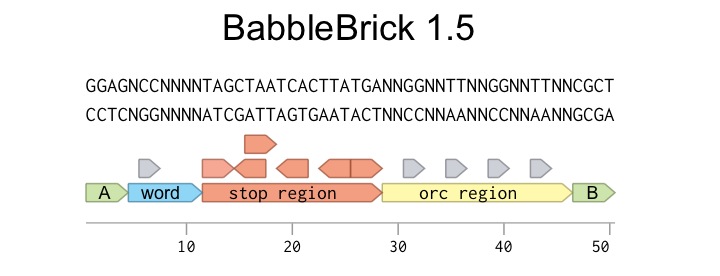F1yingFish (Talk | contribs) |
F1yingFish (Talk | contribs) |
||
| Line 7,310: | Line 7,310: | ||
<p class="lead">Word Coding Region: This region is 7bp long, 5 of which are unique to each BabbleBrick. The other two bases are spacers which prevent illegal restriction sites. There are 1024 different possible combinations of 5bases, and so we can encode 1024 different words in BabbleBricks. We have chosen 5bp for simplicity, however this can be extrapolated to 6 or 7 bases, which would give many more combinations.</p> | <p class="lead">Word Coding Region: This region is 7bp long, 5 of which are unique to each BabbleBrick. The other two bases are spacers which prevent illegal restriction sites. There are 1024 different possible combinations of 5bases, and so we can encode 1024 different words in BabbleBricks. We have chosen 5bp for simplicity, however this can be extrapolated to 6 or 7 bases, which would give many more combinations.</p> | ||
<p class="lead">The 1024 combinations are arbitrarily assigned to the data. A list of data segments, eg words, and the list of 5 base combinations are mapped together. One advantage of this design means that different libraries can be used.</p> | <p class="lead">The 1024 combinations are arbitrarily assigned to the data. A list of data segments, eg words, and the list of 5 base combinations are mapped together. One advantage of this design means that different libraries can be used.</p> | ||
| − | <div class="col-sm-6"><img src=" | + | <div class="col-sm-6"><img src="https://static.igem.org/mediawiki/2016/0/06/Edigem16ugdesigntable.png"></div> |
<div class="col-sm-6"><p class="lead">The coding sequence: ATCGG-GAGTC-GGTCA-GTAC can be made. If the computer is instructed to decode using list 1 it will read “Team Edinburgh love pizza”. If instructed to decode using list 2 it will read “iGEM is really great”.</p></div> | <div class="col-sm-6"><p class="lead">The coding sequence: ATCGG-GAGTC-GGTCA-GTAC can be made. If the computer is instructed to decode using list 1 it will read “Team Edinburgh love pizza”. If instructed to decode using list 2 it will read “iGEM is really great”.</p></div> | ||
<p class="lead">The instructions to use a certain decoding list can be in the address. | <p class="lead">The instructions to use a certain decoding list can be in the address. | ||
Revision as of 21:40, 19 October 2016






